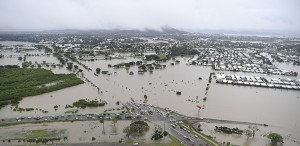Australia’s Weather Extremes
February 11, 2019
Last week, monsoon rains dumped record amounts of water in northern Queensland, Australia, flooding roads, swelling rivers above their banks, and causing landslides. The coastal city of Townsville received more than 3.3 feet (1.0 meters) of rain, raising the level of water held by the Ross River dam to dangerous levels far above its capacity. On February 3, city officials opened the dam’s gates, intentionally flooding several neighborhoods to ease pressure on the dam and keep it from collapsing. Crocodiles, snakes, and other wildlife followed the waters into the flooded streets, appearing in places they are not typically found. Boats and other vehicles capable of navigating high waters rescued many people and pets trapped by the flooding. Two people are known to have died in the flooding.

Floodwaters inundate the Townsville, Australia, suburb of Idalia on Feb. 4, 2019. Credit: © Ian Hitchcock, Getty Images
Some Queensland farmers welcomed the rainfall. Drought conditions have been widespread in recent months across Australia (where summer is from December to February), and the farmers hoped the rain would help their crops. The monsoon flooding came at the tail end of the hottest month ever recorded by Australia’s Bureau of Meteorology. On February 1, the agency reported that the average January temperature across the continent exceeded 86 ºF (30 ºC). The Australian Capital Territory, New South Wales, the Northern Territory, and Victoria all set new high temperature records for the month of January. Some parts of western Queensland and New South Wales had weeks of temperatures above 104 ºF (40 ºC). Numerous farm and wild animals died in the extreme heat, as did many fish in overheated lakes and rivers.
Despite the monsoon rains in Queensland, much of Australia remains in a drought. Scientists believe that such extreme weather events will become more frequent in coming years as a result of global climate change.


